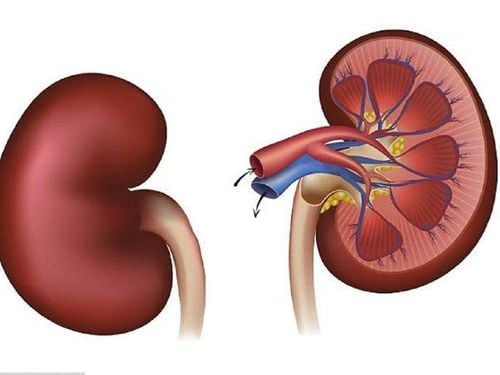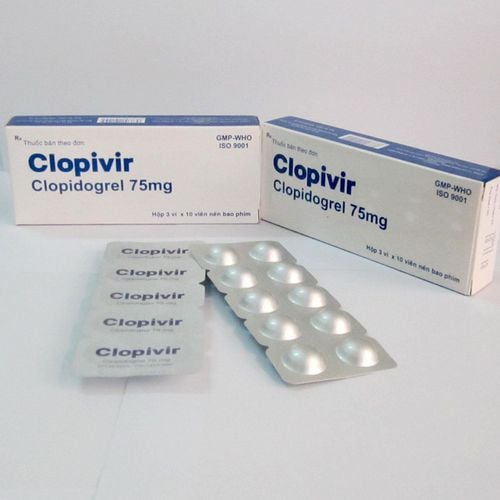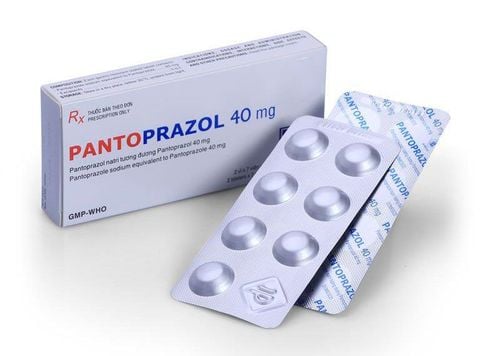This is an automatically translated article.
The article was professionally consulted with Specialist Doctor II Nguyen Quoc Viet - Department of Medical Examination & Internal Medicine - Vinmec Da Nang International General Hospital.Renal failure is a common complication of renal artery stenosis. These complications often progress for a long time, so patients have the opportunity to intervene by early detection, aggressive treatment, and lifestyle changes before the disease becomes serious.
1. Is renal artery stenosis dangerous?
The kidneys are two bean-shaped organs, consisting of the right and left kidneys, each about the size of a fist. The kidneys are located just below the rib cage, on each side of the spine. Every day, the two kidneys filter about 120 - 150 liters of blood to produce about 1 - 2 liters of urine, which consists of waste products, metabolic products and excess fluid.Renal artery separates from the corresponding aorta, just below the visceral artery. The function of the renal artery is to supply blood to the kidney as well as the blood flow to the renal hilum to perform its filtering function.
Renal artery stenosis is when the lumen diameter of one or both arteries is disproportionate for the necessary blood flow to the kidney. About 90% of renal artery stenosis cases are due to atherosclerosis, which blocks, narrows, and hardens the renal arteries. In these cases, renal artery stenosis progresses as plaque (a sticky substance made up of fat, cholesterol, calcium, and other materials found in the blood) builds up on the inner wall of one or both of them. two renal arteries. The buildup of plaque is what causes the artery walls to harden and narrow.
In addition, another cause of renal artery stenosis is fibromuscular dysplasia (abnormal growth or development of cells on the renal artery wall) that causes blood vessels to narrow. Since then, renal artery stenosis can cause stroke, kidney failure, and arterial occlusion.
2. Who is at risk for renal artery stenosis?
People at risk for atherosclerosis are also at risk for renal artery stenosis Risk factors for atherosclerotic renal artery stenosis include:High blood cholesterol levels High blood pressure Smoking leaves Insulin resistance Diabetes Being overweight or obese Lacking physical activity Having a diet high in fat, cholesterol, sodium and sugar Men over 45 years old or women over 55 years of age Family history of the disease While the risk factors for renal artery stenosis due to fibromuscular dysplasia are unknown, the disease tends to be most common in women and those aged 25 to 50 years. At the same time, the disease can also affect many people in a family, so the pathogenesis may be caused by an inherited gene.
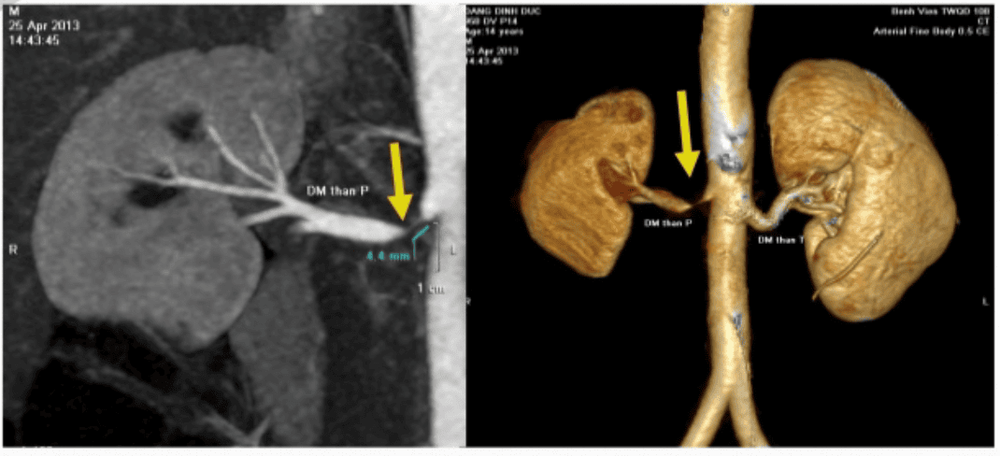
3. What are the symptoms of renal artery stenosis?
In many cases, renal artery stenosis has no symptoms until the disease becomes more severe. Common signs of renal artery stenosis are high blood pressure, decreased kidney function, or both. However, renal artery stenosis is often overlooked as a cause of high blood pressure. Therefore, renal artery stenosis is considered to be the cause of high blood pressure in subjects with the following characteristics:Over 50 years of age when found to have marked hypertension No family history of hypertension No blood pressure can be controlled with at least three different medications In addition, symptoms of impaired kidney function include:
Increased or decreased urine output Edema and swelling (usually in the legs, feet or eyes) ankles) Prolonged drowsiness or fatigue Itching or numbness of the whole body Dry skin Headache Weight loss Loss of appetite Nausea, vomiting Sleep problems Difficulty concentrating Dark skin Muscle cramps
4. What are the complications of renal artery stenosis?
People with renal artery stenosis are at increased risk of complications from loss of kidney function or atherosclerosis occurring in other blood vessels. Complications of renal artery stenosis include:Chronic kidney disease: Decreased kidney function over a long period of time. Coronary artery disease: Narrowing and stiffening of the arteries that supply blood to the heart. Stroke: Brain damage caused by lack of blood flow to the brain Peripheral artery disease: A blockage in a blood vessel that limits the flow of blood from the heart to other parts of the body, especially the legs. Because renal artery stenosis can lead to renal failure, described as end-stage renal disease, these patients to maintain renal filtration will require renal replacement therapy such as dialysis. blood or kidney transplant.

5. How to diagnose renal artery stenosis?
Because renal artery stenosis complications are very dangerous, directly affecting the health and life of the patient, so early diagnosis for timely treatment is very important. Your doctor may be able to diagnose renal artery stenosis by hearing a murmur on your abdomen in conjunction with performing imaging tests.In some cases, this diagnosis is found when a person is tested for another reason. For example, a patient was found to have renal artery stenosis during coronary angiography.
The following imaging tests are used to diagnose renal artery stenosis:
Doppler ultrasound renal artery stenosis : Doppler ultrasound imaging can show blockages in the renal arteries or blood moving through the arteries. neighboring circuits at a lower speed than normal. Ultrasonic media is non-invasive and low cost. Transcatheter angiography: This is also known as background clearing angiography. Traditional X-rays are still used, but catheters are threaded through large arteries, usually from the femoral, to the aorta and to the renal artery. Contrast will be injected and the renal artery will show up more clearly on the X-ray. This is the “gold standard” for the diagnosis of renal artery stenosis due to the very high quality of the images produced. Computed tomography angiography: This means a combination of X-rays and computer technology to create images. Contrast is injected into a vein in the arm to better see the structure of the artery. Accordingly, CT angiography is less invasive than catheter angiography and takes less time, but the risk of X-ray radiation exposure persists. Magnetic resonance angiography: The essence of magnetic resonance is to use radio waves and magnets to create detailed images of the internal organs and soft tissues of the body without the use of X-rays. However, contrast dye still needs to be injected into a vein in the arm to better see the structure of the artery.
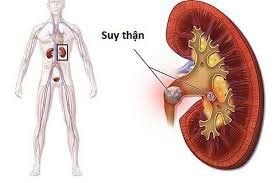
6. How to treat renal artery stenosis
Treatment is aimed at preventing the renal artery stenosis from getting worse and reducing the blockage. Treatments include:Lifestyle changes The first step in treating renal artery stenosis is making lifestyle changes to promote healthy blood vessels throughout the body, including the renal arteries. The best way to prevent plaque from building up in your arteries is to exercise, maintain a healthy body weight, and choose healthy foods. Smokers should quit to help protect their kidneys and other internal organs.
Medications People with renal artery stenosis may need to take medication to lower blood pressure. Antihypertensives, ACE inhibitors, and angiotensin receptor blockers have been shown to be effective in slowing the progression of kidney disease. In addition, diuretics, beta-blockers, calcium channel blockers, and other blood pressure medications may also be needed. In addition, diabetes control drugs, cholesterol-lowering drugs are also indicated to prevent plaque buildup in the arteries, and blood thinners (aspirin) help blood flow more easily through the arteries.
Intervention: Currently, renal artery stenosis can be easily treated with intervention, the doctor will use special instruments, put the stent (stent) in the narrow position and dilate, making the lumen of the heart. The renal arteries dilate, helping to improve blood flow to the kidneys. Surgery: Although surgery has been used in the past to treat atherosclerotic renal artery stenosis, recent studies have not shown improved outcomes with surgery compared with medication. However, surgery may be recommended for people who do not improve with medication. In a nutshell, the renal arteries are the blood vessels that carry blood from the aorta to the kidneys. Renal artery stenosis occurs when one or more of these vessels narrow, which can reduce blood flow to the kidneys, eventually leading to complications such as high blood pressure and chronic kidney failure. Although the current interventions do not have evidence of a cure, but if diagnosed and actively treated, the disease progression will slow down, thereby prolonging the time of complicated renal vascular stenosis.
Currently, Cardiovascular Center - Vinmec International General Hospital is one of the leading centers in the country for examination, diagnosis, screening and treatment of cardiovascular diseases. Vinmec not only has the convergence of a team of experienced and reputable leading experts in the field of surgical, internal medicine, interventional cardiac catheterization but also has a system of modern equipment, on par with the most prestigious hospitals in the world.
Please dial HOTLINE for more information or register for an appointment HERE. Download MyVinmec app to make appointments faster and to manage your bookings easily.





